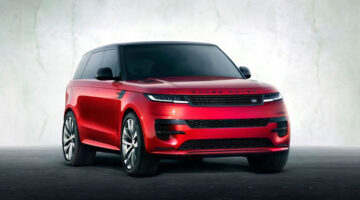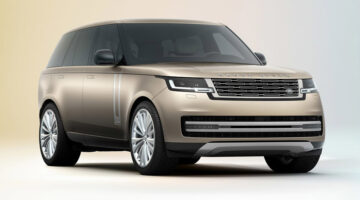This is the all-new Range Rover Evoque. It may not look it, but underneath the familiar skin, the compact Range Rover has been completely redesigned from the ground up to rival an increasing number of premium SUVs from Audi to Volvo. The original Evoque was a massive success for Land Rover, so it hasn’t taken any risks with this sequel, pulling out all the stops with a new chassis, interior and in about a year’s time, plug-in hybrid powertrains.
Visually, the Evoque doesn’t tread far from its predecessor’s recipe, sharing its basic shape and dimensions with the current model. Although it doesn’t look immediately different, study the details and you’ll see plenty of borrowed elements from the Velar, such as the flush-look LED headlights and wide rear lights. The basic surfacing has also been cleaned up, reducing the amount of lines on the body, further accentuated by the adoption of the Velar’s retractable door handles.
The new Evoque is a grand total of 1mm longer than the previous five-door (the three-door will not return thanks to sluggish sales), and is slightly lower by 11mm. Underpinning the new Evoque is an all-new platform dubbed Premium Transverse Architecture, which Land Rover insists has been designed from the outset to facilitate extensive hybridisation.
From launch, the Evoque will be available with the familiar set of four-cylinder petrol and diesel ‘Ingenium’ engines, with outputs varying between an entry-level 148bhp diesel through to a 296bhp 2-litre turbocharged petrol. All models aside from that entry diesel are fitted with a nine-speed automatic ZF transmission and all-wheel drive, which for the first time is able to operate in front-wheel drive mode under normal driving conditions to improve mileage. Also new for the Evoque is a real torque vectoring differential via a set of clutch packs on the rear axle, similar in principle with the Focus RS, although it has been calibrated more for off-road applications, so I wouldn’t expect an RS-style drift mode.
All of these powertrains are supported by a new 48V mild-hybrid system, storing electrical energy in an under-floor mounted battery, which is fed by an engine-mounted belt drive starter generator. Like similar systems in some Audis and Mercedes, this allows for a brief moment of engine-off coasting at low speeds and subtle electrical assistance under acceleration, further reducing fuel use.
Twelve months after launch, the engine range will diversify, highlighted by a plug-in hybrid model combining a new three-cylinder petrol engine and electric motor. That petrol engine will be an all-new turbocharged 1.5-litre unit sharing the Ingenium nomenclature and the tech that underpins it. Alone, it produces 197bhp, of which is combined with a 106bhp rear axle-mounted electric motor. As with most hybrid engines, the total output is not a simple sum of these two figures, as each produce max power at different points, but it should still be plenty for what’s meant to be the environmentally friendly model. Powering only the rear wheels, the electric motor is fed by an 11.3kWh battery pack, but as it’s still a year or so away, Land Rover has not revealed any performance or range figures.
Inside, the design hasn’t markedly changed, instead like the rest of the car, it takes the same theme as the current model, but modernises it with new detailing and tech. Dominating the sleeker dash is Land Rover’s Duo Touch pro system, combining two 10-inch touch screens. The infotainment software has been upgraded, finally incorporating Apple CarPlay and Android Auto.
It also introduces some other new tech, including the introduction of what JLR call a ‘Ground View technology’, putting on-screen a superimposed image of the front wheels and what is surrounding them. This tech has been developed principally for off-roading purposes, but will also be useful keeping the optional 21-inch wheels kerb-free in the urban environments it’ll more likely be up against. Another introduction is the wide-angle rear-view mirror, giving drivers the option of flicking between an actual mirror and rear-mounted wide-angle camera, improving rear visibility.
Prices are also in-line with the current model, starting at $40,500 for the entry level D150 and rising to over $64,000 for a fully-kitted out ‘First Edition’ P300 with all the bells and copper-accented whistles.
If you’re holding your breath for a hot petrol-only SVR model, you’ll probably be wasting your time, as the Evoque’s new platform is unable to support an engine any bigger than the current 2-litre Ingenium unit. However, the possibility of a hybrid-assisted performance model is more likely, such are the times. For now though, expect to see your local Waitrose crawling with the new Evoque before you know it.
This article originally appeared at
evo.co.uk





